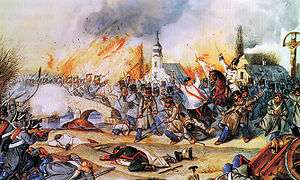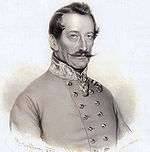Battle of Kápolna
| Battle of Kápolna | |||||||
|---|---|---|---|---|---|---|---|
| Part of the Hungarian Revolution of 1848 | |||||||
 Painting of The Battle of Kápolna by Mór Than | |||||||
| |||||||
| Belligerents | |||||||
|
|
| ||||||
| Commanders and leaders | |||||||
|
|
| ||||||
| Strength | |||||||
|
36,000 men 136 cannon |
30,000 men 165 cannon | ||||||
The Battle of Kápolna was a battle in the Hungarian Revolution of 1848, fought on 26 and 27 February 1849. The battle ended with Austrian victory and influenced the politics of central Europe: Franz Joseph I announced the March Constitution of Austria on 4 March 1849.
Prelude
Dembiński, the Polish supreme commander
László Teleki sent Henryk Dembiński, the Supreme Commander of the Polish November uprising, from Paris to the Kingdom of Hungary. Lajos Kossuth knew Dembiński well after his Lithuanian retreat.
Mad plan, bad tactics

Dembiński's appointment was misguided, because he was introverted, short-tempered, and distrustful. The Hungarian commanding officers did not like it. Dembiński had an argument with Mór Perczel, stood down György Klapka, and later had an argument with Artúr Görgey.
Dembiński’s plans were to fight the final battle at Mezőkövesd and Eger, but before this to attack the Austrian army at Szolnok. He was so obsessive about his plans that he even refused to attack Franz Schlik, even though Shlik was completely isolated. Dembiński's explanation was that if he did, Winfisch-Grätz still wanted control in Buda, which meant that the battle plans for Mezőkövesd and Eger were null and void. Dembiński stuck to his plan and drew back one of his legions from Pétervására when Klapka wanted to attack Schlik on 24 February.
Balance of forces

Windisch-Grätz saw Schilck army’s vulnerable position and the Hungarian army’s activity, so he started to move his army towards the River Tisza. On the one hand Windisch-Grätz wanted to stop the Hungarian army, but on the other he wanted to make contact with Schilck, but they only communicated through a messenger.
Windisch-Grätz’s army had 30,000 men and 165 cannon. The Hungarian-Polish-Italian army had about 43,000 men and 150 cannon, but the supreme commander only counted 36,000 men and 136 cannon. So there was a chance that the Hungarians and Poles would win on numbers, but the sticking point was for Dembiński to close up gather the Hungarian forces. But he did not.
On 26 February, at 10 a.m., the Austrian army started to move from Gyöngyös to Tarna, where they met with the Hungarian army. The first Hungarian legion, under the command of Arisztid Dessewffy, remained at Verpelét. A small commando from this legion were at Sirok. The arriving Austrian army realised that the Hungarian army was much stronger than they, and after a short fight the Austrian army started to move towards Feldebrő.
Battle
Demolished bridges on the River Tarna

Ernő Poeltenberg (German: Pöltenberg) and his Seventh Legion marched into Feldebrő around noon, and at 2 p.m. Poeltenberg moved his legion and crossed the River Tarna. First they fought with Major General Colloredo at the forest of Aldebrő. At first neither of the armies could get a decisive victory, but Colloredo got more and more reinforcements, and Poeltenberg had to retreat.
Poeltenberg got no news from his messenger, who he had sent to Káplona, so he crossed the Tarna in the middle of Austrian fire. He demolished the bridges on the Tarna, emptied Aldebrő (Lower Debrő) and Feldebrő (Upper Debrő) and retreated in the direction of Kerecsend. The Austrian army occupied the forest but they did not cross the Tarna, or occupy Aldebrő or Feldebrő.
In the meantime Dembiński arrived and gave an order to Poeltenberg to go back to the two villages. The next morning Poeltenberg was stationed at Aldebrő and Feldebrő.
Belated order

Colonel János Máriássy’s Driquet brigade, part of the First Hungarian Division, crossed the Tarna at the beginning of the battle and was stationed between the Kompolt Forest and the Kápolna vineyard.
There was a legion available for Máriássy, and with it he tried a covert attack to the rear of Franz Wyss, but it was discovered and repelled. But Máriássy’s cavalrymen still managed to blockade the Austrian army. The Hungarian army retreated in the direction of Tarna. The Second Hungarian Legion under the command of Móric Kisfaludy was stationed at Kál. Kisfaludy crossed the river after he heard the first cannon fire and attacked the Austrian army. Even though Kisfaludy’s army was weaker than the Austrian army, the Hungarian army defended its position and defeated Wyss.
Dembiński was in conference with Görgei in Eger when he heard the cannon, and they both immediately went to Kápolna. Dembiński gave an order for the rear army to advance, but only two of the legions received the order in time. Thus the legion under the command of Sulcz joined together with the legions at Verpelét, and Lajos Aulich’s legion advanced to Kál.
Sirok Channel

During the night the Hungarian army's position became worse because Schlik took control of the Sirok Channel without a fight and he was nearer to the Hungarian army at Verpelét.
The battle continued on 27 February. Wyss' main aim was to occupied Kápolna which meant that he would cross through the Hungarian army and destroy its right flank, because he knew that Schlik occupied Sirok canal and was advancing towards the right flank.
Klapka had to defend Verpelét with only one division. Dembiński gave an order to Klapka to reoccupy the Sirok Channel and sent reinforcements under the command of Poeltenberg. At the same time Dembiński ordered Görgei to lead the Hungarians at Verpelét and stop the separated divisions of the Austrian army coming together. Poeltenberg had just arrived at Verpelét when Schlik occupied it, and he tried to attack the Austrian army. Klapla, seeing the Hungarian army’s success, tried to reoccupy Verpelét, but it wasn't successful.
Ineffective attack

By this time Görgei had arrived in Verpelét. As the commander of the Dessewffy and Poeltenberg legions, Görgei held up Schlik, but he needed to retreat in the direction of Kerecsend because he did not want the Austrian army to get trapped. Dembiński commanded the Márriássy legion in a retreat from Kápolna eastwards towards the Tarna riverbank and blockaded the bridge too. Máriássy warned Dembiński that defence of Kápolna would be almost impossible, because the Austrian army, who were on the other bank of the river, still controlled Dembiński’s side too. Dembiński ignored Máriássy's warning, and started to attack to retake Kápolna.
The Hungarian divisions, commanded by Móric Psotta and Cézár Mednyánszky, were advancing to the bridgehead, but there they encountered the Austrians and capitulated. Máriássy also attacked the Austrians at a pub they were occupying in Kápolna. Because Psotta and Mednyánszky capitulated, Wyss could concentrate on Máriássy’s army and expelled it from the pub. Máriássy tried to retake, but he had to retreat in the direction of Kerecsend. However, the Austrian attack got stuck here and Windisch-Grätz tried a covert attack against the Hungarians at Tófalu.
Relief of supreme commander

Dembiński drew back the Hungarian army from Kál in the direction of the eastern bank of the Tarna. On 27 February Aulich's legions defended against the Austrian army, but before he went to reoccupy Kápolna, Aulich received an order from Dembiński to advance north and attack from there. Aulich was advancing there when he received the news that the Austrian army had defeated the Hungarian army at Kál. Because of this Aulich turned back towards Kál, but before he arrived Dembiński ordered him to retreat. At the same time that Guyon and György Kmety's legions arrived to Kerecsend, but Dembiński didn't continue the battle and gave the order for retreat. Klapka's legion's officers didn't want to follow Dembiński's advice unless one of the commanding officers confirmed it. On 3 March Bertalan Szemere arrived at Tiszafüred for a debriefing military meeting where he became the intermediary between Dembiński and the Hungarian army. Szemere visited Dembiński and tried to convince him to hold another debriefing. Because Dembiński didn't want to, Szemere relieved him of his command and gave his post to Görgey, who became the supreme commander.
See also
Sources
- Hermann, Róbert; Bona, Gábor (1996), Az 1848–49. évi szabadságharc története ("The history of the Hungarian revolution of 1848") (in Hungarian), Videopont, ISBN 963-8218-20-7
- Hermann, Róbert (2001), 1848–1849 a szabadságharc hadtörténete ("The history of the Hungarian revolution of 1848") (in Hungarian), Budapest: Korona, ISBN 963-9376-21-3
External links
- "Szöghy István kápolnai plébános korabeli írása ("István Szöghy military vicar writings")" (in Hungarian). Archived from the original on 16 February 2008. Retrieved 14 December 2009.
- "Kápolnai csata a Mult-kor történelmi portálon ("The Battle of Kápolna on the Mult-kor website")" (in Hungarian). Múlt-kor. 27 February 2004. Retrieved 14 December 2009.
- Hajagos, József. "Hajagos József írása a kápolnai csatáról ("József Hajagos writings about the Battle of Kápolna")" (in Hungarian). sulinet.hu. Archived from the original on 23 January 2010. Retrieved 14 December 2009.
- "Borus József írása a csatáról a SZTE e-könyvtárában ("József Borus's writing about the battle in the SZTE digital library")" (in Hungarian). University of Szeged Library. Retrieved 14 December 2009.
- "A kápolnai csata emlékműve ("The monument of the Battle of Kápolna")" (in Hungarian). leaderkozpont.hu. Retrieved 14 December 2009.